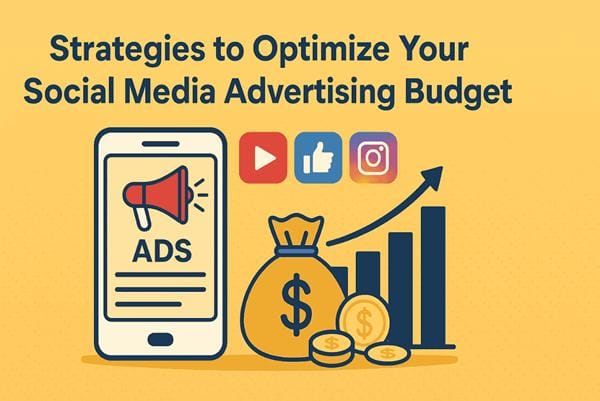
Scrolling through my ad dashboard on Meta a few years ago, I remember having looked over my burn rate and thinking, “How in the world did I just spend $500 and get just 37 clicks?” That wasn’t the worst part, though—the clicks weren’t converting. If you’re reading this, you’ve likely been there, too. It’s not that social ads don’t work—trust me, they absolutely do—but without the right plan, your budget is gobbled up faster than you can say “boost post.”
Social media advertising spend optimization is not shortcutting. It is targeted spending of your money. Having learned by doing it wrong myself so you don’t have to, this is how it is done now—lean, strategic, and ROI-driven.
Don’t Waste Money on Average Creatives
You can have the most precise in-game targeting, but without good creative, you’re wasting the budget. That was learned the hard way by comparing static image vs. competing flash vertical videos where the CTR was more than 40% higher. Visual storytelling is more crucial than ever, and Reels, in particular, are killing short-form engagement.
If you aren’t already producing how to make Instagram Reels, you’re not just behind, you’re losing. Short-form, vertical videos are the top-performing ad asset for over 68% of brands. That one switch—to drop the horizontal videos in favor of Reels—cut my spend per result by nearly half.
No matter if it’s UGC, animation, or straight talking-head footage, make it mobile-first and emotionally compelling. Flashy doesn’t need to be expensive, but it must stop the scroll.
Hyper-Targeting Can Be More Costly Than It Is Worth
I was absolutely fixated on slicing and dicing the audience when I first started using Instagram ads. Behaviors, job functions, micro-interests – oh, I was clever, I was! But sliced it so thin, my CPMs skyrocketed.
Here is the deal: hyper-targeting restricts the potential for optimization by the algorithm. Facebook machine learning does not get along if you put it into a box. Now, today, I permit broader targeting to push first and allow the algorithm to learn. Next, I retarget based on true engagers.
You shouldn’t have to micromanage who views the ad. You’d prefer to monitor who responds—and let the platform take it from there. It goes against intuition, but spreading the word can take your social advertising budget a lot farther.
Platform Rules: To Obey, Do Pay
One client had advertised one of their wellness products and was rejected four times. No one internal had looked over to make sure that the copy didn’t violate any of Meta’s ad policies. What do you think occurred? Their account got noticed, subsequent ads did not perform, and their CPMs never recovered.
Small problems—no contact info, deceptive CTAs, or account verification problems—can kill delivery. Even something as simple as whether or not Instagram requires a phone number can disqualify you from advertising. Approximately 84% of disapproved ads are due to account-level setup problems, not content.
Don’t overlook these “little” things. Trust signals matter to platforms, and price is impacted by trust. Establish your foundation properly prior to launch.
Test Or Die Trying
I want to emphasize this strongly: A/B testing is not a “nice to have,” it’s a budget insurance policy. For the first time, when I A/B test multivariate headline copy only, I’ve noticed a reduction in CPC by 19%. Same image. Same audience. Different copy.
Experiment with various image styles, caption lengths, CTAs, links placed, even emojis. With one condition, though—test one variable at a time. Too many variables changing and you won’t ever be sure which one did the trick. Advertising without testing is hazardous to your budget.
Set the control, release variants, and let the numbers speak for themselves.
Retargeting: Where the Actual Cash Is
I tell this to students over and over: if you’re not retargeting, you’re just renting an audience. Cold traffic costs more and converts worse. Warm audiences—viewers on YouTube, visitors to websites, email subscribers—are where dividends are paid.
I retargeted one of my course launch campaigns to earlier landing page visitors and Instagram engagers over the last 30 days. Exactly the same copy, same creative—yet the warm audience bought at 4.3x the rate that cold traffic did.
Don’t squander every click as if it were brand new. Build tiered retargeting stacks. Frequency cap. Rotate previous visitors to fresh offers. That is how you squeeze every buck out without burning out your list.
Your Budget Must Work Along the Funnel
One that often slips the mind is where you’re placing ads in the buyer journey. If you’re spending $2,000 on awareness top-of-funnel and doing no retargeting and no conversion spend, you’re giving top-of-funnel traffic no place to land.
I spend by zones based on their performance: top (awareness – 40%), middle (engagement – 30%), bottom (conversion/retargeting – 30%). Far from ideal,
You must map creative purpose to funnel stage as well. Top-of-funnel: fun content, middle-of-funnel: case studies or testimonials, bottom-of-funnel: hard CTAs. You balance emotion and logic, same as how buyers make their way through—and how budget does, as well.
Use Automation, But Don’t Leave It to Sleep
Automated rules, CBO, and dynamic creatives are wonderful—when you’re monitoring them. I’ve seen campaigns take off overnight because an auto-bid strategy wasn’t capping spend properly.
Automate to simplify, not to ignore. Set guidelines, reminders, and daily quotas. Regularly check in, particularly while in learning phases. The machine is wonderful, but it still needs to be adjusted by the human when it derails.
Avoid the “Try Everything” Trap
It is tempting to leap on to the newest ad form, newest platform, or flavor of the month. However, every new test costs time, effort, and spend. That is not to say you should not test—establish a threshold.
Don’t fix it if it ain’t broke. Don’t cut off Facebook lead ads that are converting for $3 apiece just because some guy on YouTube said it was on fire. I’ve decided to choose two fundamentals and one wild card every quarter. That attention by itself has curbed wasteful expenditures—and outcomes more readily quantifiable.
FAQs
How do I know if my social media advertising budget is optimized?
If your cost per result is consistently decreasing while conversions go up, you’re on the right track. Always compare against past performance, not industry averages.
What’s the minimum budget I need to start testing social ads?
I recommend at least $300 per test cycle to get statistically meaningful data. Anything less makes optimization harder and the results too noisy to trust.
Should I focus on one platform or spread my budget across many?
Start with one or two platforms where your audience is most active. Master those, get returns, and then expand. Stretching too thin from the start usually leads to poor data and wasted money.





